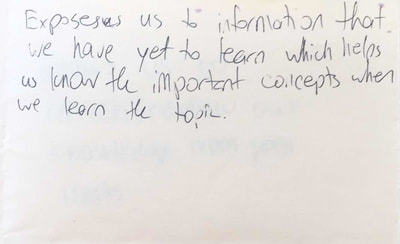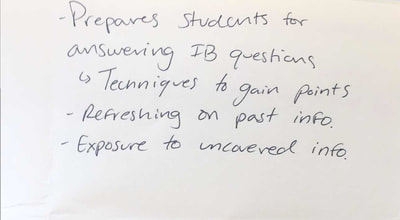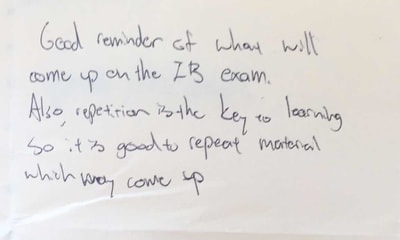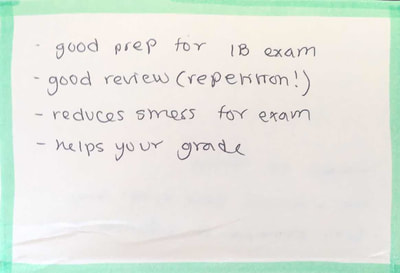Daily Quizzes
In IB Biology 2, there is a review quiz EVERY DAY. Why??
How are the quizzes formatted? Students pick up a 1/4 piece of paper upon entry to class each day. They format their paper like this for constancy and to help in my paper management task. The type of question depends on the day of the school week:
The topic of the quiz depends on the day of the month, according to this schedule.
Are the questions and mark schemes available in advance? Examples are available to review. These examples may or may not be the actual question asked on a quiz. Just click here.
How long does this take?
Depending on the day, there is a 5-10 minute time limit on quizzes. In general, students have about 5 minutes to answer the question and then the class spends about 5 minutes scoring.
How are the quizzes scored? There is NO WAY one teacher could score all of these quizzes every day. So, we use a peer grading system. Students turn their quizzes in to a central location, and then the papers are randomly redistributed to other students. The mark scheme for the question prompt is displayed on the screen and the students mark their peer's paper with the letters that pair to the mark scheme. A total score is indicated on the paper and shared with the quiz taker. Students discuss any discrepancies between perceived versus earned score. If a student doesn't agree with a score that their peer has given them, they highlight their name on the quiz paper and I will automatically rescore it. After scoring, the papers are turned back into the same central location and a volunteer student will organize the quizzes into numerical order (each student has a unique class number that pairs with their alphabetical listing in the gradebook, that way when I have the stack of quizzes, they are already in order for quick spot check and easy score entry into the gradebook).
Initially, all of the quiz scores are put into a gradebook category that is "No Count," meaning, the raw quiz scores do not have immediate impact on a student's grade. Only the quiz scores for units that we have learned in class will be recorded in this category. Students will see their raw quiz score (for example 2 out of 5) but the raw scores are not included in the class grade. The raw scores are meant to be informative, to let the student practice with IB questions and reflect on their knowledge of the material. It's the overall, cumulative average quiz score that ends up mattering, because at the midpoint and end of each grading period, the cumulative average is used to determine a score that is placed in the gradebook category for quizzes. These cumulative quiz scores do count. For more about how I set up the IB Biology II gradebook, click here.
This sounds like a lot of work. Is it worth it?
It is understood that the thought of a daily quiz can be intimidating for students. However, trust me! Year after year students have communicated their appreciation for the true learning that daily self assessments allow. Here are some comments from former students about the benefits of a daily quiz:
- See this blog post about why quizzing everyday is such a powerful learning tool
- Read this article from the New York Times explaining the value of quizzes and tests in learning.
- Skim this article outlining the Ten Benefits of Frequent Self Testing.
How are the quizzes formatted? Students pick up a 1/4 piece of paper upon entry to class each day. They format their paper like this for constancy and to help in my paper management task. The type of question depends on the day of the school week:
- "Multiple Choice Monday" - Mondays are always a 5 question multiple choice on the review material for that day and the Saturday and Sunday before the quiz. The questions are all from past Paper 1 IB exams. 5 minute maximum.
- “Table Team Tuesday” or “We Wisdom Wednesday.” Tuesday and Wednesday quizzes are a table team effort. Students will collaborate to answer a data-based question from paper 2 or paper 3. 10 minute maximum.
- "Thinking Thursday" - On Thursday, student have to put on their thinking caps to individually respond to an extended response question from a past paper 2 or 3 IB exam. 5 minute maximum.
- "Figure Friday" - The Friday quiz will involve drawing and labeling a biological figures, as is often required in questions from paper 2 or 3 of the IB exam. 5 minute maximum.
The topic of the quiz depends on the day of the month, according to this schedule.
Are the questions and mark schemes available in advance? Examples are available to review. These examples may or may not be the actual question asked on a quiz. Just click here.
How long does this take?
Depending on the day, there is a 5-10 minute time limit on quizzes. In general, students have about 5 minutes to answer the question and then the class spends about 5 minutes scoring.
How are the quizzes scored? There is NO WAY one teacher could score all of these quizzes every day. So, we use a peer grading system. Students turn their quizzes in to a central location, and then the papers are randomly redistributed to other students. The mark scheme for the question prompt is displayed on the screen and the students mark their peer's paper with the letters that pair to the mark scheme. A total score is indicated on the paper and shared with the quiz taker. Students discuss any discrepancies between perceived versus earned score. If a student doesn't agree with a score that their peer has given them, they highlight their name on the quiz paper and I will automatically rescore it. After scoring, the papers are turned back into the same central location and a volunteer student will organize the quizzes into numerical order (each student has a unique class number that pairs with their alphabetical listing in the gradebook, that way when I have the stack of quizzes, they are already in order for quick spot check and easy score entry into the gradebook).
Initially, all of the quiz scores are put into a gradebook category that is "No Count," meaning, the raw quiz scores do not have immediate impact on a student's grade. Only the quiz scores for units that we have learned in class will be recorded in this category. Students will see their raw quiz score (for example 2 out of 5) but the raw scores are not included in the class grade. The raw scores are meant to be informative, to let the student practice with IB questions and reflect on their knowledge of the material. It's the overall, cumulative average quiz score that ends up mattering, because at the midpoint and end of each grading period, the cumulative average is used to determine a score that is placed in the gradebook category for quizzes. These cumulative quiz scores do count. For more about how I set up the IB Biology II gradebook, click here.
This sounds like a lot of work. Is it worth it?
It is understood that the thought of a daily quiz can be intimidating for students. However, trust me! Year after year students have communicated their appreciation for the true learning that daily self assessments allow. Here are some comments from former students about the benefits of a daily quiz:






